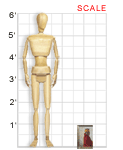VAM galleries including this work:
Frazier Historical Arms Museum | Go Figure || VAM Home
Elbridge Ayer Burbank (1858-1949)
CHIEF GERONIMO, APACHE, 1899
Oil on canvas; 12" X 10"
2001.22
Photograph by John Fitzgerald
Courtesy of the Frazier Historical Arms Museum
“Once I moved like the wind. Now I surrender to you, and that is all.”
Geronimo (1829-1909) was one of the most determined and courageous Native American leaders to resist government removal of his people from treaty-protected reservations during the late 19th century. Beginning in the mid-1870s, the Apache warrior led numerous raids against white settlements in areas of Arizona and New Mexico. In March 1886, Gen. George Crook captured Geronimo and coerced him into signing a treaty agreeing to relocate the Chiricahua Apache to Florida. Two days later, Geronimo escaped and resumed raiding. Gen. Nelson Miles pursued him into Mexico, finally catching him in September. The Chiricahua were sent to Florida, to Alabama, and finally to Oklahoma Territory, where they took up farming.
By the time of his death in 1909, Geronimo was a celebrated but somewhat tragic figure. He had toured briefly with Buffalo Bill’s Wild West Show, appeared at the 1896 St. Louis World’s Fair, and taken part in the inaugural parade of President Theodore Roosevelt in 1905. He eventually adopted Christianity and dictated his memoirs, which were published in 1906.
To paint the great warrior, Elbridge Burbank traveled to Fort Sill in the Oklahoma Territory, where Geronimo was confined, and befriended him. According to the artist, Geronimo’s “keen, shrewd face was deeply furrowed with strong lines. His small black eyes were watery, but in them there burned a fierce light.” Burbank also described the chief’s reaction to his portrait: “He turned, laughed, and slapped me on the back.”
About the Artist
Elbridge Ayer Burbank was born in Harvard, Illinois, in 1858. After graduating from the Art Institute of Chicago, he was offered a job at Northeast magazine. His assignment of painting Western scenes to advertise land sales for the Northern Pacific Railway took him through the Rocky Mountains to the Washington coast.
In 1886, Burbank went to Munich, Germany, to study under artists Paul Nauen and Frederick Fehr. When he returned to Chicago in 1890, he focused on portraiture, primarily members of high society and African Americans. Columbia Museum then commissioned Burbank to create portraits of well-known American Indians. These commissions prompted Burbank to produce what eventually amounted to more than 1,200 images of Native American Indian leaders and tribesmen from roughly 125 different tribes. Burbank got along well with his Native American subjects, who were frequent guests at his home. Before his death in 1909, Chief Geronimo told Burbank that he liked him more than any other white man he had known.
During his lifetime, Burbank was a frequent exhibitor at the National Academy of Design, the Art Institute of Chicago, and the Pennsylvania Academy of the Fine Arts.
Classroom Ideas
Discussion: About his most frequent subjects, Burbank once said, “One can’t do a good natural job on the average white person. They always want ‘this put in’ or ‘that taken out.’ [African Americans] are not that way. If a tooth is out, they want it out and I want to leave it out... And the Indians I discovered were about the same.” Compare this portrait of Geronimo to the portraits of other leaders in the KVAM, such as the portrait of George Washington by Gilbert Stuart in the University of Kentucky Art Museum gallery and the portraits of Henry Clay and Dennis Doram in the Kentucky Historical Society gallery. Do any of the portraits seem more idealized than others? What does this portrait make you think about Chief Geronimo? Research Geronimo and decide whether you think the portrait is an accurate representation. Discuss the dilemma for artists of portraying subjects accurately versus creating portraits that are flattering.
Activity: Choose a historical figure and create a portrait conveying an image of that person. How might your portrayal differ if you want to portray the subject in a positive versus a negative light?
Links
View images of other paintings of Native Americans by Burbank at the Smithsonian American Art Museum.
[americanart.si.edu/search/search_artworks1.cfm?StartRow=1&ConID=656&format=short&db=onlyart&LastName=&FirstName=&Title=&Accession=&Keyword]
For more links to Burbank works and resources online, see the Artcyclopedia.
[www.artcyclopedia.com/artists/burbank_elbridge_ayer.html]
Indian Painter, an article about Burbank’s life and work, is archived on the Artnet site.
[www.artnet.com/magazine/reviews/cassidy/cassidy5-22-02.asp?C=1]
Find out more about the life of Chief Geronimo in the Houghton Mifflin Encyclopedia of North American Indians.
[college.hmco.com/history/readerscomp/naind/html/na_013300_geronimo.htm]
The Education World web site includes information, curriculum ideas, and resources for teaching about Native Americans.
[www.education-world.com/a_lesson/lesson038.shtml]

